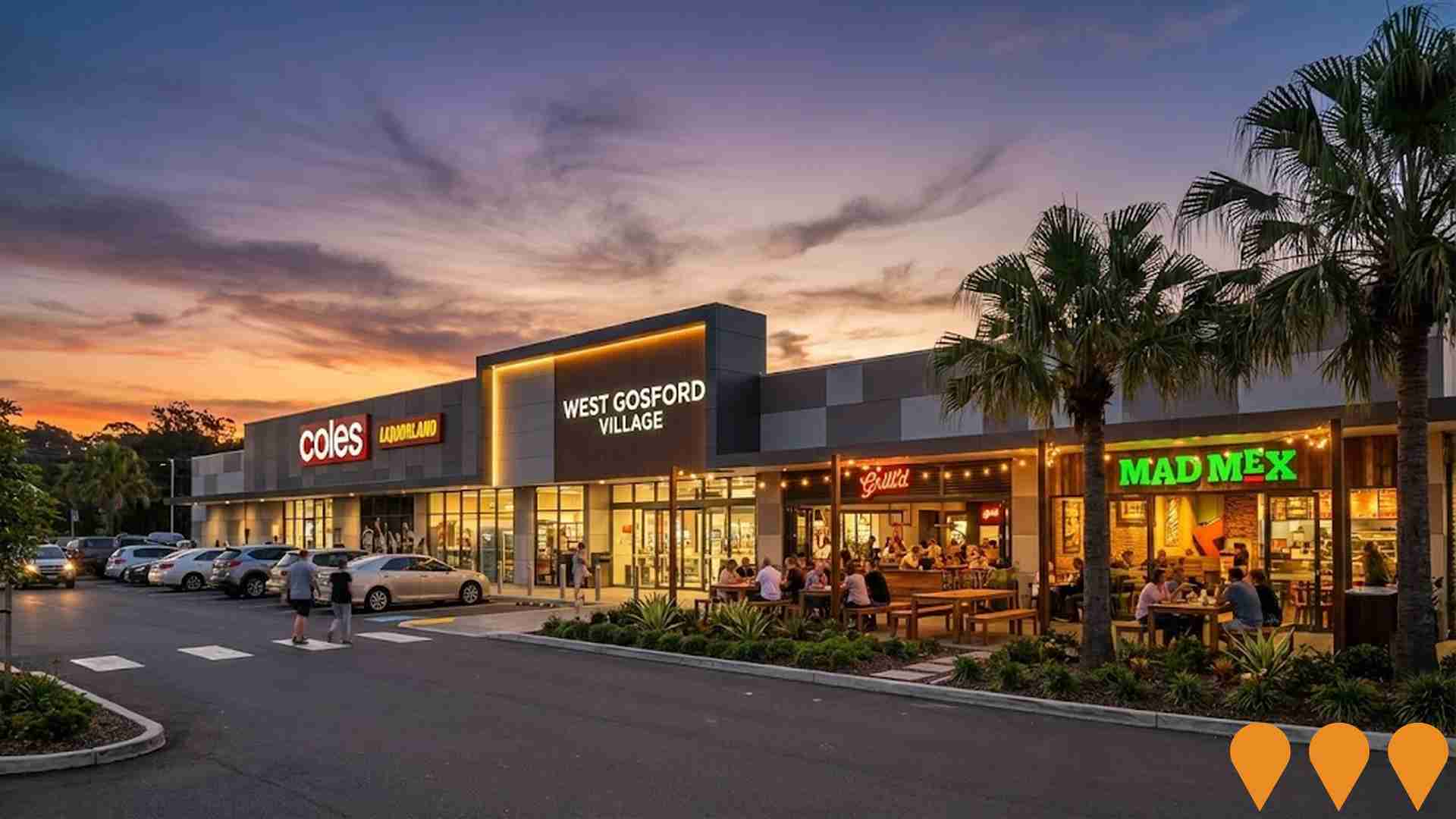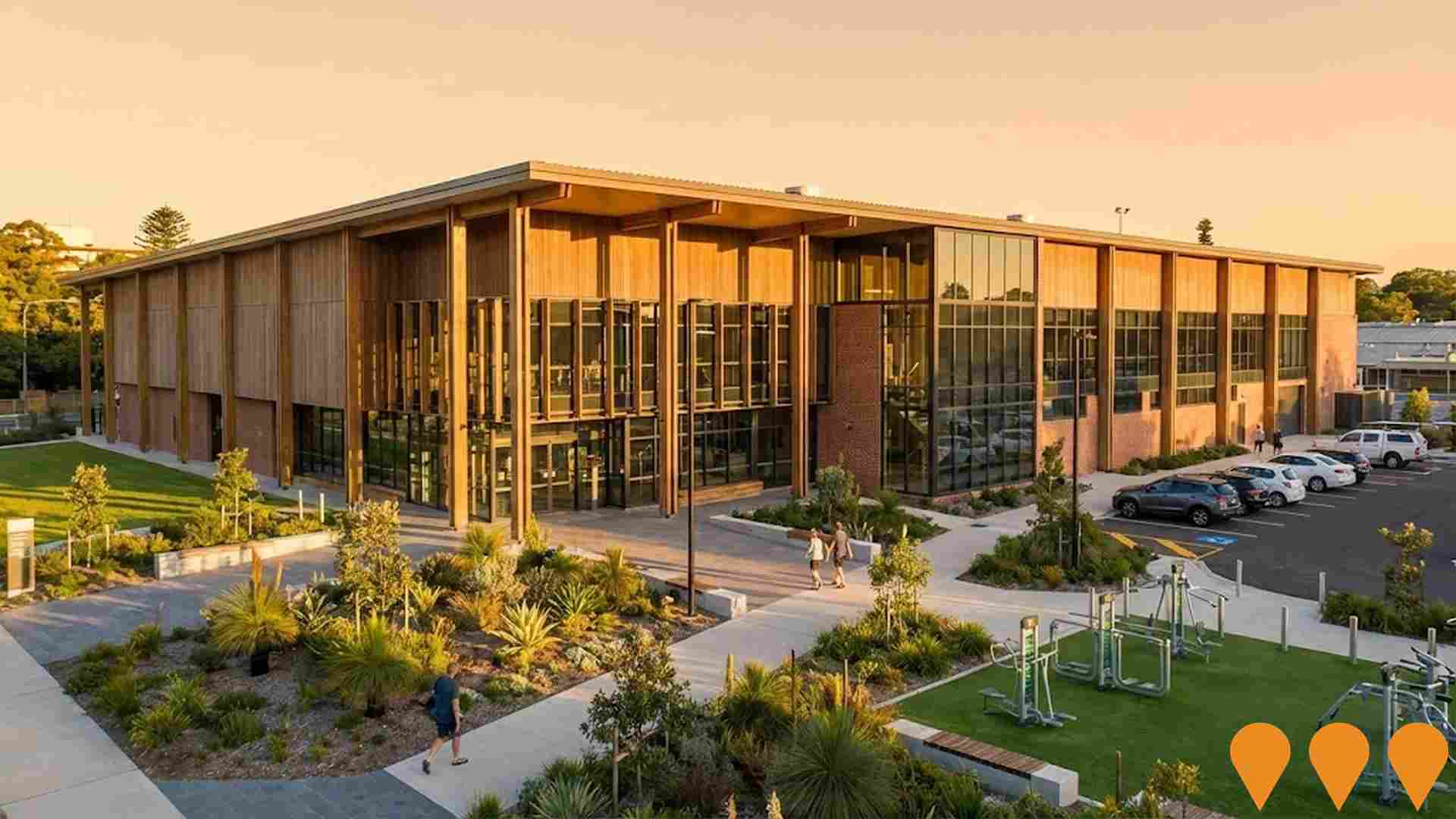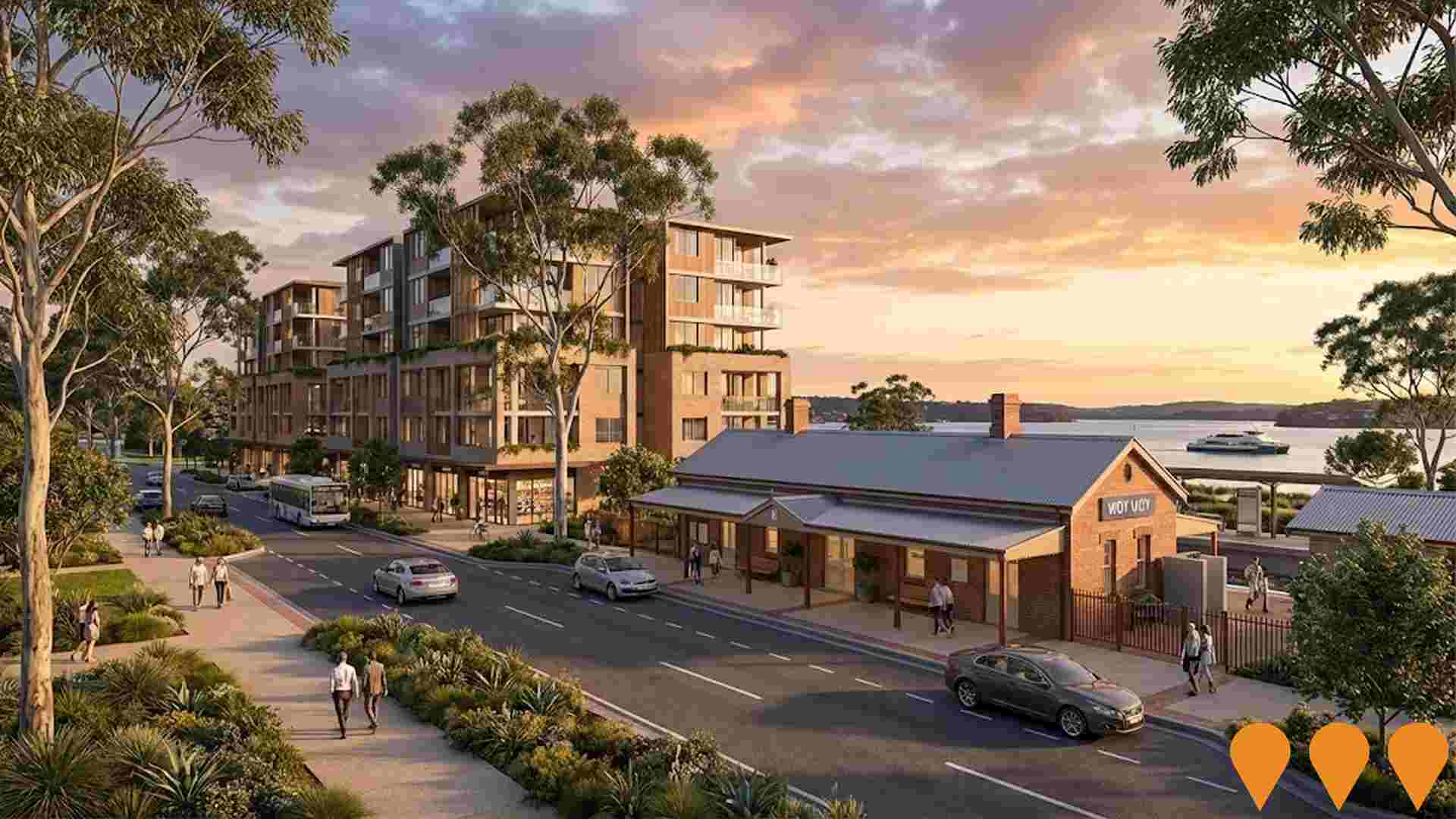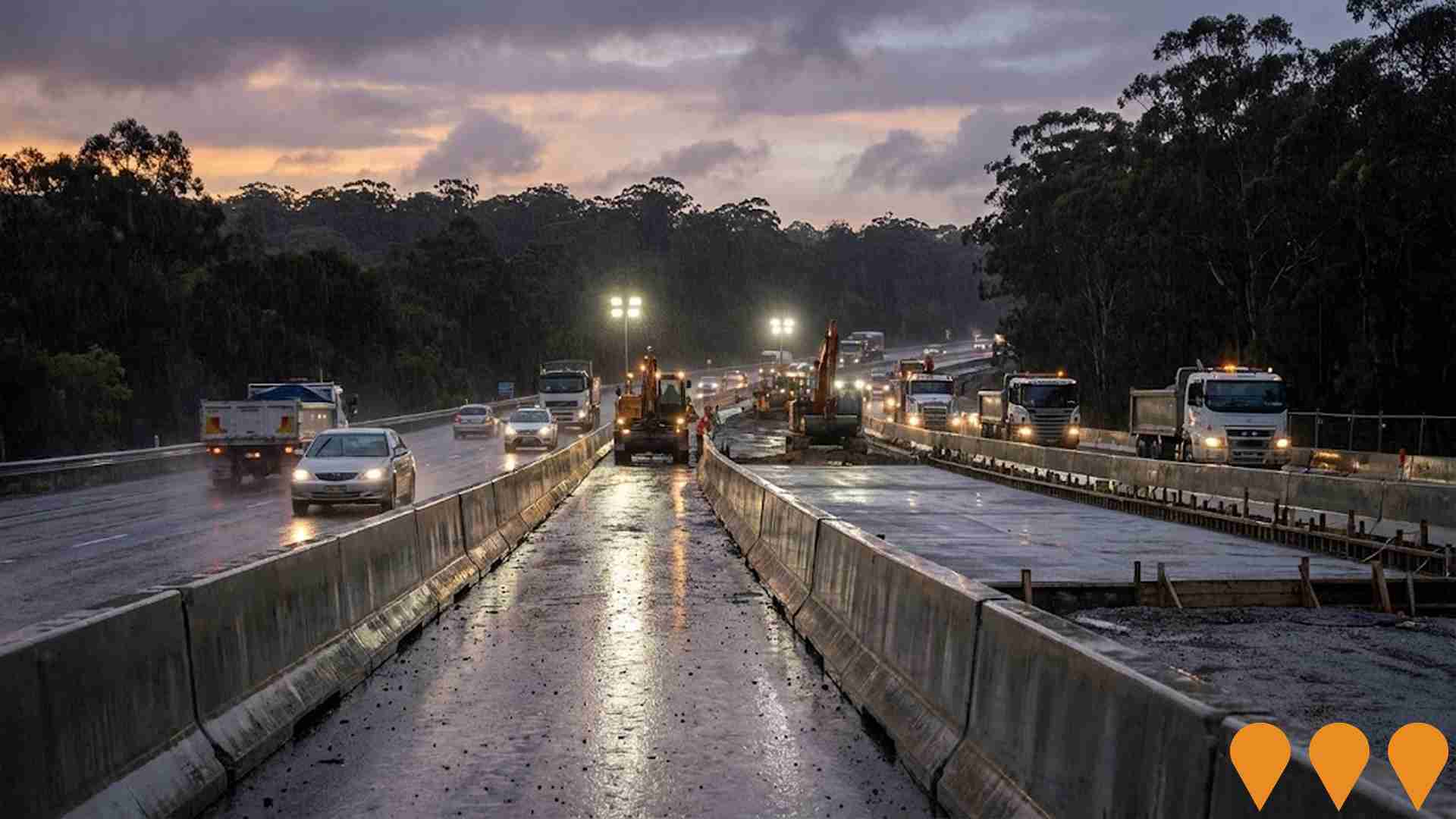Chart Color Schemes
est. as @ -- *
ABS ERP | -- people | --
2021 Census | -- people
Sales Activity
Curious about local property values? Filter the chart to assess the volume and appreciation (including resales) trends and regional comparisons, or scroll to the map below view this information at an individual property level.
Find a Recent Sale
Sales Detail
Population
Point Clare - Koolewong is positioned among the lower quartile of areas assessed nationally for population growth based on AreaSearch's assessment of recent, and medium term trends
Point Clare - Koolewong's population is around 6,692 as of Aug 2025. This reflects an increase of 121 people since the 2021 Census, which reported a population of 6,571 people. The change is inferred from the estimated resident population of 6,667 from the ABS as of June 2024 and an additional 15 validated new addresses since the Census date. This level of population equates to a density ratio of 987 persons per square kilometer. Point Clare - Koolewong's growth rate of 1.8% since census positions it within 0.5 percentage points of the SA3 area (2.3%), demonstrating competitive growth fundamentals. Population growth for the area was primarily driven by overseas migration, contributing approximately 87.4% of overall population gains during recent periods.
AreaSearch is adopting ABS/Geoscience Australia projections for each SA2 area, released in 2024 with 2022 as the base year. For areas not covered by this data, AreaSearch utilises NSW State Government's SA2 level projections, released in 2022 with 2021 as the base year. Growth rates by age group from these aggregations are applied to all areas for years 2032 to 2041. Projections indicate a decline in overall population over this period, with the area's population expected to contract by 8 persons by 2041. However, growth across specific age cohorts is anticipated, led by the 75 to 84 age group, projected to expand by 204 people.
Frequently Asked Questions - Population
Development
Residential development activity is lower than average in Point Clare - Koolewong according to AreaSearch's national comparison of local real estate markets
Point Clare-Koolewong has averaged approximately six new dwelling approvals each year over the past five financial years, totalling 30 homes. As of FY26, two approvals have been recorded. Historically, around 5.1 new residents per year arrive for each dwelling constructed between FY21 and FY25. This indicates that demand significantly outpaces supply, which typically puts upward pressure on prices and increases competition among buyers.
The average construction cost value of new homes is $418,000, reflecting more affordable housing options compared to regional norms. Additionally, $2.5 million in commercial development approvals have been recorded this financial year, suggesting the area's residential character. Relative to Greater Sydney, Point Clare-Koolewong has significantly less development activity, with 76.0% fewer approvals per person. This scarcity of new homes typically strengthens demand and prices for existing properties, reflecting the area's maturity and possible planning constraints. Recent development has been entirely comprised of detached dwellings, maintaining the area's traditional suburban character focused on family homes appealing to those seeking space.
With around 1664 people per approval, Point Clare-Koolewong shows a mature, established area. Population projections indicate stability or decline, suggesting reduced housing demand pressures and benefiting potential buyers in the future.
Frequently Asked Questions - Development
Infrastructure
Point Clare - Koolewong has strong levels of nearby infrastructure activity, ranking in the top 40% nationally
Changes in local infrastructure significantly affect an area's performance. AreaSearch has identified ten projects that could impact this region. Notable projects include Gosford Hospital Redevelopment, Gosford Community Recreation Centre, West Gosford Village Shopping Centre Refurbishment, and Henry Parry Drive Upgrade. The following list details those most likely to be relevant.
Professional plan users can use the search below to filter and access additional projects.
INFRASTRUCTURE SEARCH
 Denotes AI-based impression for illustrative purposes only, not to be taken as definitive under any circumstances. Please follow links and conduct other investigations from the project's source for actual imagery. Developers and project owners wishing us to use original imagery please Contact Us and we will do so.
Denotes AI-based impression for illustrative purposes only, not to be taken as definitive under any circumstances. Please follow links and conduct other investigations from the project's source for actual imagery. Developers and project owners wishing us to use original imagery please Contact Us and we will do so.
Frequently Asked Questions - Infrastructure
Gosford Hospital Redevelopment
Major $348 million hospital redevelopment featuring new 11-storey clinical services building, new front entrance, expanded emergency department, intensive care unit, birthing suite, maternity ward, rehabilitation unit, and cardiac catheterization labs. Teaching hospital affiliated with University of Newcastle with modern patient accommodation facilities and upgraded operating theatres.

West Gosford Village (Shopping Centre) Refurbishment
Multi-million dollar refurbishment of West Gosford Village including upgraded Coles supermarket, new alfresco dining precinct (e.g., Grilld, Mad Mex), new medical precinct, and a childcare centre. Works focused on modernising amenities, facade refresh, and creating a stronger local dining and services offer.

Gosford Community Recreation Centre
Concept for a new council-run recreation facility in Gosford providing indoor multi-sport courts, fitness spaces and bookable community rooms. No specific DA or site identified on the public record; aligns with Council leisure network planning and broader Gosford activation initiatives.

Transport Oriented Development - Woy Woy Station Precinct
State Government Transport Oriented Development (TOD) program targeting Woy Woy Railway Station Precinct for increased housing supply and density up to six storeys within 400m of the train station. The planning controls commenced on 13 May 2024, allowing for residential flat buildings and shop top housing. Encourages sustainable, mixed-use development including residential, commercial, and community facilities to create vibrant, walkable communities with improved connectivity, public spaces, and urban design. Requires infrastructure upgrades including to Woy Woy Road connection to M1. Part of broader NSW TOD SEPP reform and Central Coast development strategy to address housing needs near transport hubs.

Gosford CBD Smart City Infrastructure
Smart city upgrades delivered across Gosford CBD including 260+ IoT parking sensors (integrated with the ParkSpot app), public-space lighting, wayfinding, laneway activations and safety-focused place improvements around the transport interchange. Works were delivered by Central Coast Council with Transport for NSW support through the Safer Cities: Her Way program (Oct 2023-Jun 2024), with Council's 2024 evaluation reporting significant improvements in perceived safety.

M1 Pacific Motorway Kariong to Somersby Widening
Widening of M1 Pacific Motorway between Kariong and Somersby interchanges to improve traffic flow and reduce congestion on this critical corridor between Sydney and Newcastle.

Blackwall Road Intersection Upgrades
The NSW Government is investing $19 million in upgrades to three key intersections on the Woy Woy Peninsula: Blackwall and McMasters Road, Blackwall, Allfield and Farnell Roads, and Memorial Avenue, Barrenjoey Road and Maitland Bay Drive. The project aims to improve travel times, safety, and traffic flow for the 22,000 vehicles using the Blackwall Road corridor daily. Works commenced in July 2025 and include new traffic lights, pedestrian-activated signals, dual right-turn lanes, and improved pathways. The upgrades will future-proof the Peninsula's critical transport spine as the Central Coast continues to grow.

Henry Parry Drive Upgrade
Council completed works along Henry Parry Drive including installation of a new sewer main between Shortland Street and Frederick Street (completed mid-2024, weather dependent) and night works to improve line marking between Compton Street and York Street in January 2025. These works form part of broader Gosford CBD upgrades to support growth and improve traffic operations and network reliability.

Employment
Employment conditions in Point Clare - Koolewong demonstrate strong performance, ranking among the top 35% of areas assessed nationally
Point Clare-Koolewong has a well-educated workforce with notable representation in the technology sector. Its unemployment rate was 2.4% as of June 2025.
In the past year, estimated employment growth was 2.1%. As of June 2025, 3,335 residents were employed, with an unemployment rate of 1.8%, below Greater Sydney's rate of 4.2%. Workforce participation was 57.6%, compared to Greater Sydney's 60.0%. Leading employment industries were health care & social assistance, retail trade, and professional & technical services.
The area showed strong specialization in health care & social assistance (130% of the regional level). Finance & insurance was under-represented (4.1% vs Greater Sydney's 7.3%). Employment opportunities appeared limited locally, with Census data showing fewer working residents than expected based on population. Between June 2024 and June 2025, employment levels increased by 2.1%, labour force grew by 2.7%, causing unemployment to rise by 0.5 percentage points. Greater Sydney recorded higher employment growth (2.6%) but a similar increase in labour force (2.9%), with unemployment rising less (0.3%). Jobs and Skills Australia's forecasts from May 2025 projected national employment growth of 6.6% over five years and 13.7% over ten years. Applying these projections to Point Clare-Koolewong's employment mix suggested local growth of approximately 7.0% over five years and 14.3% over ten years, though these are simple extrapolations for illustrative purposes only.
Frequently Asked Questions - Employment
Income
Income levels align closely with national averages, indicating typical economic conditions for Australian communities according to AreaSearch analysis
AreaSearch's latest postcode level ATO data for financial year ending June 2022 shows that Point Clare - Koolewong has an average national income level. The median income is $50,362 and the average income is $65,431. In contrast, Greater Sydney's median income is $56,994 and average income is $80,856. Based on a 12.61% increase since financial year ending June 2022, current estimates for Point Clare - Koolewong would be approximately $56,713 (median) and $73,682 (average) as of September 2025. The 2021 Census data indicates that household, family, and personal incomes in Point Clare - Koolewong rank modestly, between the 42nd and 48th percentiles. Income distribution shows that the largest segment comprises 30.4% of residents earning $1,500 to $2,999 weekly. This is similar to the surrounding region where 30.9% fall into this bracket. Housing affordability pressures are severe in Point Clare - Koolewong, with only 84.3% of income remaining after housing costs, ranking at the 49th percentile. The area's SEIFA income ranking places it in the 6th decile.
Frequently Asked Questions - Income
Housing
Point Clare - Koolewong is characterized by a predominantly suburban housing profile, with above-average rates of outright home ownership
In Point Clare-Koolewong, as per the latest Census evaluation, 89.4% of dwellings were houses, with the remaining 10.6% being semi-detached, apartments, or 'other' dwellings. This compares to Sydney metropolitan areas having 74.2% houses and 25.9% other dwellings. Home ownership in Point Clare-Koolewong was 38.1%, with mortgaged dwellings at 37.7% and rented ones at 24.1%. The median monthly mortgage repayment in the area was $2,000, below Sydney's average of $2,150. The median weekly rent figure was recorded at $400, matching Sydney's average. Nationally, Point Clare-Koolewong's median monthly mortgage repayments exceed the Australian average of $1,863, while rents are higher than the national figure of $375.
Frequently Asked Questions - Housing
Household Composition
Point Clare - Koolewong has a typical household mix, with a fairly typical median household size
Family households constitute 70.5% of all households, including 31.6% couples with children, 27.0% couples without children, and 10.8% single parent families. Non-family households account for the remaining 29.5%, with lone person households making up 26.8% and group households comprising 2.8%. The median household size is 2.5 people, which aligns with the Greater Sydney average.
Frequently Asked Questions - Households
Local Schools & Education
The educational profile of Point Clare - Koolewong exceeds national averages, with above-average qualification levels and academic performance metrics
Point Clare - Koolewong has educational qualifications that trail regional benchmarks. 29.2% of residents aged 15+ hold university degrees, compared to Greater Sydney's 38.0%. Bachelor degrees are most common at 18.8%, followed by postgraduate qualifications (6.8%) and graduate diplomas (3.6%). Vocational credentials are prominent, with 37.8% of residents aged 15+ holding them - advanced diplomas at 13.0% and certificates at 24.8%.
Educational participation is high, with 27.4% currently enrolled in formal education: primary (9.6%), secondary (7.0%), and tertiary (4.3%). Point Clare Public School serves the area, with an enrollment of 489 students as of a recent date. The school focuses on primary education, with ICSEA score of 1055 indicating above-average socio-educational conditions. Secondary options are available in surrounding areas. Local school capacity is limited at 7.3 places per 100 residents compared to the regional average of 15.9, leading many families to travel for schooling.
Frequently Asked Questions - Education
Schools Detail
Nearby Services & Amenities
Transport
Transport servicing is good compared to other areas nationally based on assessment of service frequency, route connectivity and accessibility
Point Clare - Koolewong has 84 active public transport stops. These are served by a mix of trains and buses along 17 individual routes. Together, these routes facilitate 1,060 weekly passenger trips.
The accessibility of transport is rated as excellent, with residents typically located just 169 meters from the nearest stop. On average, there are 151 trips per day across all routes, which translates to about 12 weekly trips per individual stop.
Frequently Asked Questions - Transport
Transport Stops Detail
Health
Health performance in Point Clare - Koolewong is well below average with prevalence of common health conditions notable across both younger and older age cohorts
Point Clare - Koolewong faces significant health challenges, as indicated by its health data. Both younger and older age groups have a notable prevalence of common health conditions.
The area has approximately 52% private health cover, which is slightly higher than the average SA2 area but lower than Greater Sydney's 54.7%. The most prevalent medical conditions are arthritis (9.3%) and mental health issues (8.9%). About 64.0% of residents report having no medical ailments, compared to 64.8% in Greater Sydney. As of 2016, 24.2% of the population is aged 65 and over, totaling 1,616 people. The health outcomes among seniors are generally aligned with those of the broader population.
Frequently Asked Questions - Health
Cultural Diversity
The level of cultural diversity witnessed in Point Clare - Koolewong was found to be above average when compared nationally for a number of language and cultural background related metrics
Point Clare-Koolewong has a higher cultural diversity than average, with 10.9% of its residents speaking a language other than English at home and 22.9% born overseas. Christianity is the predominant religion in Point Clare-Koolewong, comprising 51.5% of the population, compared to 53.4% across Greater Sydney. The top three ancestry groups are English (31.6%), Australian (25.0%), and Irish (9.5%).
Notably, Welsh (0.8%) is overrepresented in Point Clare-Koolewong compared to the regional average of 0.7%, Scottish (9.1% vs 7.9%), and South African (0.7% vs 0.5%).
Frequently Asked Questions - Diversity
Age
Point Clare - Koolewong hosts an older demographic, ranking in the top quartile nationwide
The median age in Point Clare-Koolewong is 46, which is higher than Greater Sydney's average of 37 and the Australian median of 38. The 75-84 age cohort is over-represented in Point Clare-Koolewong at 9.5%, compared to Greater Sydney's average. Meanwhile, the 25-34 age group is under-represented at 7.6%. According to the 2021 Census, the 75-84 age group has increased from 8.6% to 9.5% of the population, while the 25-34 cohort has decreased from 9.0% to 7.6%. By 2041, the 75-84 age cohort is projected to expand by 179 people (28%), from 638 to 818. Those aged 65 and above are expected to comprise 80% of this growth. Conversely, the 5-14 and 55-64 age groups are forecasted to experience population declines.



